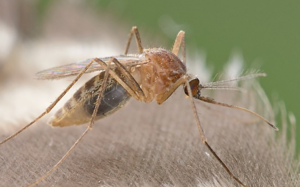 The oldest known mosquito with an anatomy similar to modern species was found in 79-million-year-old Canadian amber. Ever since, they’ve been a pain in the the… well, arm, neck, hands, feet, legs, pretty much any exposed skin of human and animal alike. By the way, Tuff Turf’s mosquito program runs through October.
The oldest known mosquito with an anatomy similar to modern species was found in 79-million-year-old Canadian amber. Ever since, they’ve been a pain in the the… well, arm, neck, hands, feet, legs, pretty much any exposed skin of human and animal alike. By the way, Tuff Turf’s mosquito program runs through October.
The female mosquito’s saliva is transferred to the host during the bite, and can cause an itchy rash. Additionally, many of the species can ingest pathogens while biting, and transmit them to future hosts. Mosquitoes are important factors in the spread of diseases such as malaria, yellow fever, Chikungunya, West Nile, dengue fever, filariasis, Zika and other arboviruses – many of which we’ve mentioned before in other posts. By transmitting diseases, mosquitoes cause the deaths of more people than any other animal group: over 700,000 each year.
Mosquitoes are found almost everywhere except Antartica and Iceland and tend to be more prevalent in areas of higher humidity, temperature and precipitation. According to a recent NBC news story… “A rare but deadly virus spread by mosquitoes has been detected in different parts of the country, and scientists say a combination of rainy weather and warmer winters is to blame. The virus, Eastern Equine Encephalitis (or EEE) primarily infects horses and birds in the eastern US. However, when it makes its way to humans, the disease is particularly virulent, often leading to severe neurological problems.”
Usually confined to the lower eastern Atlantic and gulf coast states EEE, like ZIKA, has been moving northward. In Massachusetts, one death from EEE has been reported, and three other cases have been diagnosed. In Michigan, health officials have confirmed one case in a teenage girl, and are investigating other potential cases. The virus has also been found in three horses in Massachusetts, six horses and two deer in Michigan, two horses in Connecticut and four chickens in Delaware this month. Mosquito samples also show the virus was present in New Hampshire.
The majority of people who are infected with EEE might never know it – fewer than 5 percent actually develop encephalitis (inflammation of the brain), but for those who do fall ill, the illness is swift and devastating. Symptoms start four to 10 days after a person is bitten and include headache, high fever, chills and vomiting. As the disease progresses, the patient can experience disorientation, seizures and coma.
The CDC says the best way to avoid EEE is to avoid mosquito bites.”
THANKS for that! In other words, that means using an EPA-approved mosquito repellent, wearing long sleeves and pants in wooded, swampy areas, and getting rid of standing water in flower pots, bird baths and anything else in your yard that holds water.
Did we mention that Tuff Turf’s mosquito program runs through October.


Comments (0)
Thanks for your comment!
Thanks for your feedback! Your comments have been successfully submitted! Please note, all comments require admin approval prior to display.
Error submitting comment!
There is a problem with your comment, please see below and try again.